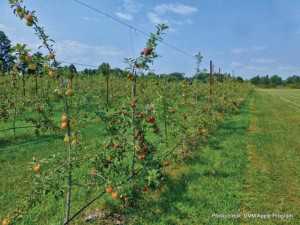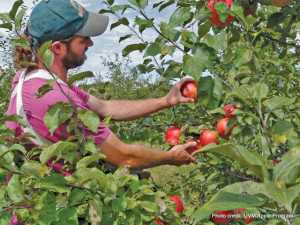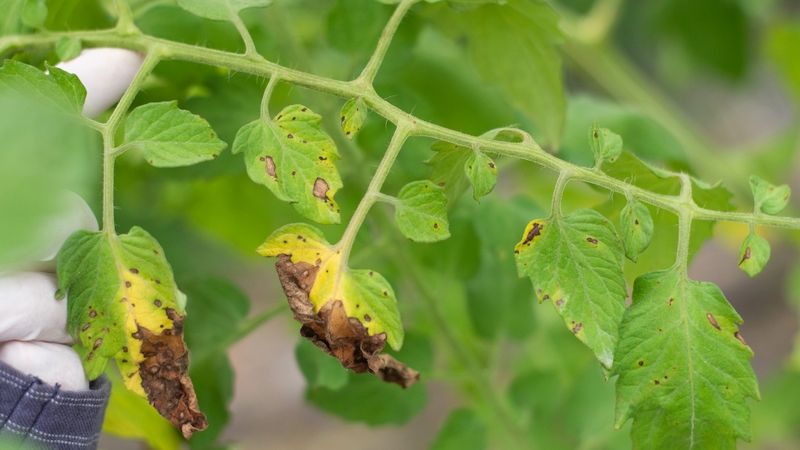Piecing Together The Organic Puzzle

OrganicA, a multi-state and multi-school research program designed to study the feasibility of growing apples organically in New England, is based at the University of Vermont Horticulture Research Center. (Photo credit: UVM Apple Program)
The OrganicA project was launched in 2006 as part of a USDA-Organic Research & Extension Initiative (OREI) grant. This project is a collaboration between universities and stakeholders to study the feasibility of growing organic apples in New England. The research orchard is located at the University of Vermont (UVM) Horticultural Research Center in South Burlington, VT, with four test plots, two active in research. The orchard received organic certification in 2008.
The Early OrganicA Plots
The first research plot, Orchard 1, is 0.4-acres planted in 2006 with Ginger Gold, Liberty, Macoun, and Zestar! on Bud.9 and Honeycrisp on M.26 in a randomized pattern. Orchard 2 was an existing 0.75 acres of Liberty and McIntosh on M.26 planted in 1988 and top-grafted with Ginger Gold, Liberty, Macoun, Honeycrisp, and Zestar!
In the early orchards, a sulfur-based spray was applied to all the trees to prevent apple scab, even on Liberty, which has the Vf gene resistance to scab. The research team noticed that although scab was controlled, tree growth, low yield, and fruit size was a problem.
“We associate this to the sulfur and lime sulfur phytotoxicity, poor rootstock choice (Bud 9 in a sandy soil with low soil organic matter), and ground cover management issues during orchard establishment,” says Terence Bradshaw, UVM Apple & Grape team research specialist and assistant director of the UVM Horticulture Research Center.

Ginger Gold, due in part to the variety’s vigor, performed well in the early OrganicA apple orchards at UVM. (Photo credit: UVM Apple Program)
Out of all the varieties, Ginger Gold performed the best, due in part to Ginger Gold’s vigor offsetting the phytotoxicity of the sulfur treatments.
“Ginger Gold has actually performed quite well, but not as well as I would ideally like to see in Orchard 1,” says Bradshaw. “The interesting thing with Ginger Gold is, it is extremely susceptible to just about every disease out there; if you name it, Ginger Gold gets it.”
Currently Ann Hazelrigg, instructor with the UVM Extension, is conducting a holistic orchard treatment in Orchard 1. Orchard 2 does not have any research being conducted on it. Orchard 3 is used for insect monitoring and rearing beneficial mites.
Learning Over Time
Bradshaw and his research associates took the lessons they learned in the first plots and applied them into a new planting in 2011. Tree spacing was shortened from 5 feet between trees to 4. The rootstock was upped from a Bud 9 to M.26, because of the research station’s sandy and loamy soil. A mulching program that proved successful in the first plots was used and mating disruption was deployed through the whole orchard.
“If rootstock and vigor are matched to the site, we get higher and sooner yields, better fruit quality, and decreased labor inputs. If trees are stunted for any reason (phytotoxicity from sulfur or lime sulfur, poor rootstock choice, poor weed management) then high-density systems will not pay off,” says Bradshaw.

“When it comes to growing organic apples in this area, while I think I’ve got some of the pieces of the puzzle, the whole program isn’t put together yet,” says Terence Bradshaw, research specialist and assistant director of the UVM Horticulture Research Center. (Photo credit: UVM Apple Program)
The 2011 orchard was also planted as feathered saplings in tall spindle. Scab-resistant varieties of Crimson Crisp, Crimson Gold, Crimson Topaz, Florina Querina, Galarina, Liberty, William’s Pride, and Winecrisp were intentionally selected to reduce the need for sulfur sprays.
“The summer (of 2013) was so wet, a lot of summer disease was observed on many cultivars (sooty blotch, flyspeck, Brooks spot). We feel that adjusting to a modest fungicide program may help manage these diseases in the future,” says Bradshaw. “Even though many fruit were superficially ugly, crop yield was very good, with one cultivar producing 490 bushels per acre of fruit averaging 145 grams (about 120 count size) each.”
Funding Future
The USDA-OREI grant for the OrganicA project ends in July and there hasn’t been a call for the new applications for the grant in the past few years. For now, the research team is piecing together funds.
This year, Bradshaw is compiling the results, including an economic analysis of the eight years of research. Bradshaw mentioned that he has interest from hard cider producers in using the OrganicA model as a cost-effective way to grow hard cider varieties.
“This is an opportunity not necessarily to be an organic grower, but to reduce the production costs significantly by changing the pest management program. You can apply pest management programs, whether they’re organic or not, and have that 50% threshold in terms of fresh market fruit,” says Bradshaw. “There’s a whole lot more damage that can go into the cider varieties even more so than applesauce apples or other additional processing fruit where the internal cosmetics are still pretty important.”
For more information on the OrganicA program, visit uvm.edu/~organica/index.html.










